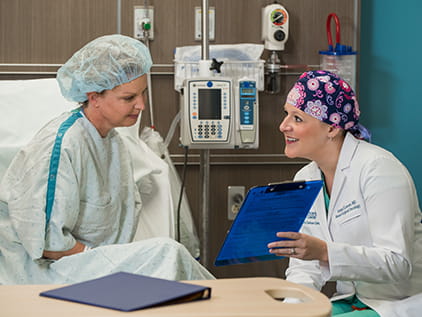Lymphedema Surgery
Lymphedema is a condition where lymph fluid or fatty tissues build up under the skin, causing pain, swelling and discomfort. It is a common side effect of cancer treatments that require the removal of lymph nodes. Lymphedema often occurs in the arms or legs.
The University of Kansas Health System offers the region's only surgical lymphedema treatment program. Our medical staff is dedicated to supporting you through comprehensive care.
What is lymphedema surgery?
Prevention and conservative therapy are the main forms of treating lymphedema. Compression sleeves, massage therapy and physical exercise have all been shown to reduce the risk of lymphedema. Early detection of lymphedema is critical to successful treatment.
However, when lymphedema reaches an advanced or critical stage, surgery to repair damaged lymph nodes and remove fatty buildup may be required.
Doctors perform lymphedema surgery to repair damaged or removed lymph nodes so that lymphatic fluid no longer builds up under the skin. In advanced cases, doctors also often remove the fatty deposits that have already formed.
We offer a variety of appointment types. Learn more or call 913-588-1227 to schedule now.
Who can have lymphedema surgery?
Lymphedema can occur after trauma or injury, but is most often a side effect of cancer treatment. This condition is typically seen in people with bladder, gynecologic or prostate cancers, and in those who have had lymph nodes removed or who have received radiation therapy. Lymphedema is a common side effect of breast cancer treatments.
Lymphedema alone is not typically a life-threatening condition, but it can seriously impact your quality of life as well as create a risk for serious infections.
The best candidates for lymphedema surgery are those who have not responded to nonsurgical lymphedema treatments. Those whose lymphedema has progressed to a critical stage will also usually receive surgery.

Cancer care you can count on
The University of Kansas Cancer Center is 1 of fewer than 60 NCI-designated comprehensive cancer centers in the nation, and it's part of The University of Kansas Health System.
How does lymphedema surgery work?
The goal of any lymphedema surgery is to reduce and heal the damage to the lymphatic system. There are 2 categories of lymphedema surgery: physiological operations and debulking operations.
Surgical treatment options for lymphedema include:
Benefits and risks of lymphedema surgery
All surgical procedures come with some risks. Infection, bleeding and complications arising from anesthesia and medicine are associated with virtually all types of surgery. However, the success rates for lymphedema surgery are high.
Most people who receive lymphatic bypass surgery report greatly increased improvement, and notice reduced tightness, heaviness and fatigue in their arm or leg along with reduced swelling. Liposuction results are almost immediate, although patients will need to wear a compression sleeve long-term.
What happens during lymphedema surgery?
Many of the techniques used in lymphedema surgery are minimally invasive and involve the usage of small, finely tuned instruments. Microsurgical techniques to treat lymphedema include lymphatic bypass or lymph node transfer, which may improve lymphatic circulation and decrease symptoms and risk of infection.
The least invasive surgery to treat lymphedema is lymphatic bypass. This involves injecting dye into the hand to help map lymphatic channels in the body, which are then identified microscopically through small incisions in the arm. Once pinpointed, the channels are redirected into neighboring veins to reroute the lymphatic flow to avoid the obstruction in the armpit.
Lymph node transfer is another surgical option, although it is more invasive and usually reserved for people with long-standing lymphedema. Debulking, or the removal of fibro-fatty tissue, is used to treat people with chronic lymphedema.
Liposuction is a debulking procedure frequently used to treat lymphedema. It can remove 1-2 liters of fibro-fatty tissue, allowing the arm to return to its normal size.

Plastic surgery services
Learn more about the plastic surgery program at The University of Kansas Health System.
Why choose us for lymphedema surgery
Medical researchers at The University of Kansas Health System are at the forefront for detecting and treating lymphedema. Our doctors not only specialize in the newest and least invasive surgical techniques, but also focus a great deal of research on early detection and prevention.
The University of Kansas Health System uses Sozo to screen for lymphedema. Sozo can detect subtle changes earlier than symptoms appear allowing an opportunity to prevent or reverse lymphedema in many instances. We are the only health system in the country that offers a true lymphedema prevention program.

Turning Point
Turning Point offers free classes, programs and tools designed to empower and educate people affected by chronic or serious illness.




